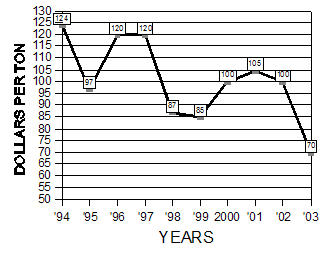Alfalfa Report
Yuma County, Arizona
December 1, 2003
Yuma County Office
2200 W. 28th Street, Ste. 102
Yuma, AZ 85364
(928) 726-3904
(928) 726-8472 FAX
Production Update:
Phytophthora Root Rot: Phytophthora
Root Rot caused by the fungus Phytophthora megasperma was
a major contributor to stand decline in Arizona before 1980. The importance
of this disease has been lessened by the introduction of resistant varieties
and by elimination of waterlogging. Phytophthora root rot is a cool season
disease induced by wet conditions. A rotted taproot is characteristic
of this disease, although leaves turn yellow and drop and lesions also
appear on the roots. Infected fields can be saved by providing soil drainage.
Lateral roots developing above the infected area can replace the function
of the decayed tap root.
Insect Management: Spotted alfalfa aphid (SAA) (picture)
caused severe
damage to alfalfa in Arizona and California in the 1950s. Control
was achieved through a combination of introduced parasites and host plant
resistance. SAA still occasionally causes problems, but generally only
when susceptible cultivars are grown. Since 1996, SAA has occasionally
appeared in damaging numbers in highly resistant alfalfa varieties. A
number of seedling alfalfa fields needed to be treated for SAA during
the fall of 2002. The reasons for the appearance of this aphid in highly
resistant cultivars is being investigated. There is every reason to believe
that the highly resistant cultivars will continue to keep the SAA in check
along with the indigenous and introduced natural enemies. SAA develops
better under warm temperatures than pea aphid or blue alfalfa aphid.
Weed Control: Common groundsel (picture)
is a weed in the composite family that has appeared in La Paz County and
is becoming increasingly widespread. It has not been reported in Yuma
County. It is a difficult-to-control weed that can be poisonous to cattle
and horses.
| Market Summary |
High
|
Low
|
Average
|
Off grade
|
| Past 2 Weeks (Nov. 18 - Dec 1, 2003) |
80
|
55
|
70
|
50-55
|
| Last Year (Nov 18 - Dec 1, 2002) |
105
|
95
|
100
|
70-90
|
10 Year Summary (Nov 18 - Dec 1, 1994-2003):

Issued in furtherance of Cooperative Extension work, acts of May 8 and June 30, 1914, in cooperation with the U.S. Department of Agriculture, James A. Christenson, Director Cooperative Extension, College of Agriculture and Life Sciences, The University of Arizona.
The University of Arizona is an equal opportunity, affirmative action institution. The University does not discriminate on the basis of race, color, religion, sex, national origin, age, disability, veteran status, or sexual orientation in its programs and activities.
Any products, services, or organizations that are
mentioned, shown, or indirectly implied in this web document do not imply
endorsement by The University of Arizona.
Information provided by:
Barry Tickes, btickes@ag.arizona.edu Extension Agent, Yuma County
Michael Ottman, mottman@ag.arizona.edu Agronomy Specialist
College of Agriculture, The University of Arizona.
Eric Natwick, etnatwick@ucdavis.edu UCCE Imperial County - Farm Advisor
University of California, Davis, CA.
Forages: Crop Mgmt | Soil Mgmt | Irrigation | Alfalfa Reports | Insects | Diseases | Weeds | Pesticides
Home | Other Crops | Forages
For more Arizona Production Ag Information:
Home | Cotton | Veggies| Forages | Grains | Citrus | Crop x Crop | Insects | Diseases| Weeds | Pesticides | News | Weather | Research | Photos | Contacts | General Info. | Site Map
Copyright © 2001 University of Arizona,
College of Agriculture and Life Sciences
Webmaster: Al Fournier (fournier@ag.arizona.edu)